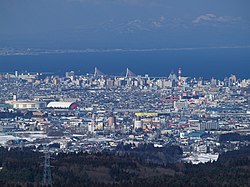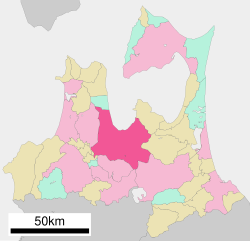Aomori, Aomori
|
Aomori 青森市 |
|||
|---|---|---|---|
| Core City | |||
 |
|||
|
|||
 Location of Aomori in Aomori Prefecture |
|||
| Coordinates: 40°49′20.4″N 140°43′50.6″E / 40.822333°N 140.730722°ECoordinates: 40°49′20.4″N 140°43′50.6″E / 40.822333°N 140.730722°E | |||
| Country | Japan | ||
| Region | Tōhoku | ||
| Prefecture | Aomori Prefecture | ||
| Government | |||
| • Mayor | Akihiko Onodera | ||
| Area | |||
| • Total | 824.61 km2 (318.38 sq mi) | ||
| Elevation | 2 m (7 ft) | ||
| Population (September 2015) | |||
| • Total | 288,029 | ||
| • Density | 349/km2 (900/sq mi) | ||
| Time zone | Japan Standard Time (UTC+9) | ||
| City symbols | |||
| • Tree | Maries' fir | ||
| • Flower | Rosa rugosa | ||
| • Bird | Ural owl | ||
| • Insect | Firefly | ||
| Phone number | 017-734-1111 | ||
| Address | 1-22-5 Chūō, Aomori-shi, Aomori-ken 030-8555 | ||
| Website | City of Aomori | ||
Aomori (青森市 Aomori-shi?) is the capital city of Aomori Prefecture, in the northern Tōhoku region of northern Japan. As of September 2015, the city had an estimated population of 288,029 and a population density of 349 persons per km2. The total area of the city was 824.61 square kilometres (318.38 sq mi).
Aomori literally means blue forest, although it could possibly be translated as "green forest". The name is generally considered to refer to a small forest on a hill which existed near the town. This forest was often used by fishermen as a landmark. A different theory suggests the name might have been derived from the Ainu language.
The area has been settled extensively since prehistoric times, and numerous Jōmon period sites have been found by archaeologists, the most famous being the Sannai-Maruyama Ruins located just southwest of the city center dating to 5500-4000 BC, and the Komakino site slightly further south dating to around 4000 BC. The large scale of these settlements revolutionized theories on Jōmon period civilization. During the Heian period, the area was part of the holdings of the Northern Fujiwara clan, but remained inhabited by the Emishi people well into the historic period. After the fall of the Northern Fujiwara in the Kamakura period, the territory was part of the domain assigned to the Nambu clan, and into the Sengoku period, it came under the control of the rival Tsugaru clan, whose main castle was located in Namioka. After the start of the Edo period, Aomori was a minor port settlement for Hirosaki Domain called Utō (善知鳥村 Utō-mura?). The town was rebuilt in 1626 by Moriyama Yashichirō, under orders of the daimyō, Tsugaru Nobuhira and renamed Aomori, but the name did not come into common use until after 1783.
...
Wikipedia



